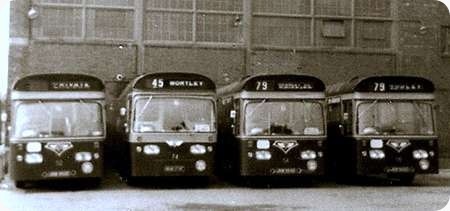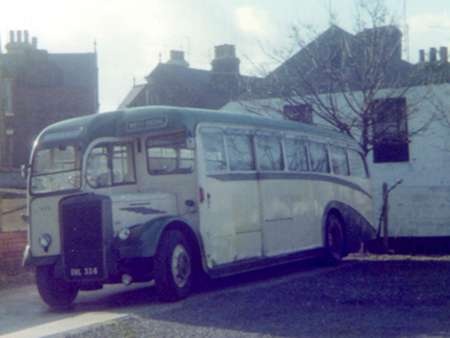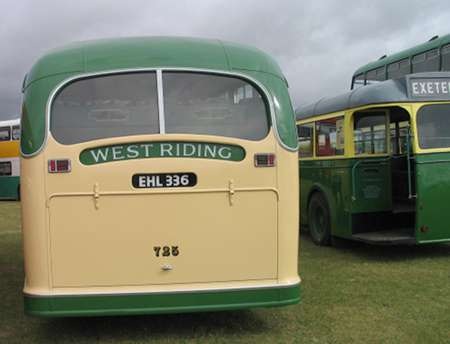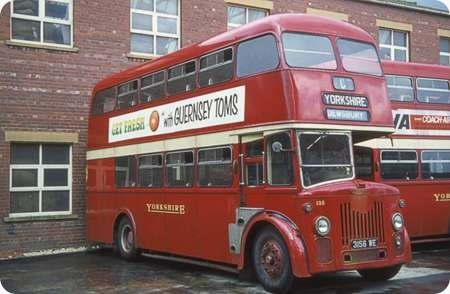Leeds City Transport – AEC Swift – JNW 952E – 52
Leeds City Transport
1967
AEC Swift MP2R
Roe B48D
Leeds bought several batches of AEC Swifts between 1967 and 1971. Prior to these appearing the fleet was 90% double deck with around 15 saloons most of which were AEC Reliances some with centre entrance bodies with the later ones being dual door for one man operation.
Seen here are a quartet of the first two batches of Swifts parked outside the old Bramley depot which was a former tram depot.
Three of the Swifts have Roe bodywork of an attractive style while the fourth carries an MCW body which had forward sloping window pillars and a slightly stepped waistrail. Further saloons in the shape of both Swifts and single deck Fleetlines would appear before the last Roe bodied Swifts entered service in 1971. All of the buses seen here carry their original dark green with light green windows livery that was basically reversed when it was decided to paint one man operated buses in a different style to the rear entrance fleet. All of the Swifts passed to the PTE and had a largely normal life span. From the left they are 52 JNW 952E, 74 MNW 174F the solitary MCW example seen here and 54 and 56 from the same batch as 52.
Photograph and Copy contributed by Chris Hough
05/09/13 – 14:30
Leeds City Transport plus Roe bodywork is pretty much as one might expect, since the factory was within the boundary. MCW? However did that idea get past Committee???
Pete Davies
05/09/13 – 14:30
A matter of personal preference I know Chris, but I thought that the traditional Leeds City Transport livery as shown here was the very best – corporate and completely dignified, inside and out. The various batches of Swifts each had fascinating characteristics, often considerably different and interesting (challenging even) in their own ways. The first fifty as shown in the picture had semi automatic transmission while the final batches of fifty and twenty had the option of fully automatic or, if drivers like me preferred, manual override so as to allow "normal" gearchanging of a sort. In fairness though the fully automatic mode on these was normally very predictable and well behaved. All things considered, the final twenty (1051 – 1070) with luxury seats were the best of the lot and were a delight to drive and to ride in. Passenger flow in the last seventy was really excellent and they were ideal for one person operation. Rumour had it, we shall never know on what foundation, when the last twenty were on order that they would be of 12 metres length – its a good job that they weren’t, as some of the corners on the inner city routes would have been literally impossible – the turn from the nearside lane of East Parade into Park Lane (Headrow) being one certainty. Thanks again for a really nostalgic picture Chris.
Chris Youhill
06/09/13 – 08:21
Peter Leeds had a long history of dual sourcing bodywork between Roe and MCW although the Swifts were the first saloons.
Chris I too preferred the original liveries seen here although the doors were a little eccentric since the exit door was half the width of the entrance. The Park Royal examples were much better in having both doors of normal width. The Roe 1971 batch had fronts derived from the Leeds two door decker design and as you say were a joy to ride on. I recall that they were replaced on the Ring Road service with Duple bodied Tigers which were also a pleasant ride. One thing that has always struck me about the MCW bodied Swifts was their apparent narrowness at the front compared to the Roe examples.
Chris Hough
06/09/13 – 08:22
By 1967/8 MCW had been Leeds’ ‘backup’ supplier of bodywork for the best part of two decades. It was widely believed that it was possible to get more advantageous quotes from suppliers by multi-sourcing.
David Call
10/09/13 – 06:33
You are right Chris, and the MCW do appear narrower and even allowing for slightly different camera angle its very strange indeed – but must somehow be just an illusion ??
The Tigers were truly superb vehicles, mechanically and bodily, and the luxurious brown patterned moquette seats were the finest. They did indeed replace the Swifts on the Ring Road service entirely, and I think on most other single deck routes from Headingley Depot – memory not clear, although it should be, on the last point but its getting now to be a long time ago – I eagerly took redundancy from the forthcoming "circus" on October 25th 1986. On joining South Yorkshire Road Transport after that I encountered daily more Tigers but with OPO adapted Plaxton luxury coachwork – these really were the bees knees for stage carriage work, and one of them still enjoyed a working radio – the others having been silenced because of arguments arising on private hires and excursions – and whenever I had number 22 on bus services (often) the passengers were able to enjoy Radio Two.
Chris Youhill
10/09/13 – 16:30
Like Chris, I have a great deal of affection for the TRCTL11 Tigers. [A shame there were no TRCTL12s – AEC men will know what I mean.]
David Oldfield
10/09/13 – 16:30
Going off at a bit of a tangent here, but at Halifax we had some of the Tigers to which Chris refers. They became regular performers on the ex-Hebble Rochdale service, along with its later alternative variant via the incredibly narrow and tortuous lanes around Mill Bank and Soyland. They certainly romped along compared with ex-West Yorkshire Leopard coaches which we also had at the time, though they always gave me the impression of not being quite so durable. They were also without any doubt the worst buses I have ever had to drive in snow and ice.
However, I would question Chris’s views on their bodywork. They had Duple Dominant Bus bodies, and were apparently built in stages, the works giving priority to coach production and fitting ours in as and when they had a bit of spare time. Our chap whose job it was to monitor the construction of the PTE’s buses paid a visit to the works and found their basic steel frameworks had been assembled and then dumped outside in the yard with inadequate (or possibly no) rustproofing to suffer the worst of the salty Blackpool sea air. They were already rusting away and a strong request was made (in no uncertain broad Yorkshire terms I can well imagine !) to get them treated straight away. This was apparently carried out, but apparently not very well, and they began to suffer corrosion problems from quite an early stage in their lives. There were two batches, and I think it was the first batch of seven Y-reg ones (which went to Leeds) which suffered the worst, but one of our A-prefix ones was subject to quite a major rebuild later and became the only one to carry the white, blue and yellow First Calderline livery, and the last to survive.
John Stringer
11/09/13 – 08:30
But John, they were Duples. The reason that the firm folded was because of the appalling quality and finish. Your story helps explain why the metal frames were so prone to rust and corrosion. The fit and finish left a lot to be desired on the 320/340 bodies at the end (1989). I know of at least one Western National 340/Tiger where the panels were coming adrift after a few months and I drove a 320/Scania where I thought that the engine cover had counterbalancing until I was told it was rusted metal "sloshing" about in the cavity. How are the mighty fallen. Duple were at the top of their game when they moved to Blackpool and had an honourable history with the Continental and Commander but seemed to lose the plot after that. The Dominant was an Elite rip off – but with a metal frame. Somehow it never worked – despite the Continental being a successful metal-framed model. MCW had exactly the same corrosion problems despite the MCCW metal frames being the best of their time.
David Oldfield
11/09/13 – 16:30
Following on from Davids comments. It is interesting that the PTE/Yorkshire Rider never went for the National (one batch only) and Calderdales last pre low floor saloon were Plaxton bodied Volvos.
Chris Hough
12/09/13 – 08:30
John and David – I can only say that I amazed to hear of such structural inferiority in the Duple Dominant bodies, but naturally don’t doubt it for a minute on hearing such reliable reports. All I can say is that, in their "youth", the Headingley PTE Tiger ones were superbly comfortable and free of any rattling or body noise and movement – as the saying goes "You can’t judge a book by its cover." !!
Chris Youhill
Quick links to the - Comments Page - Contact Page - Home Page






